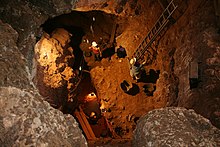Santa Ana Cave

The Santa Ana Cave is, like the caves of Maltravieso and El Conejar, in a military exclusion zone in the Karst area (Calerizo de Cáceres) about 12.0 kilometers east of Cáceres in Extremadura in Spain .
The Santa Ana Cave is located on a limestone hill of Carboniferous , near a slate formation , characterized by a change in the slope of the terrain. During the excavation, seven stratigraphic planes were identified at a depth of five meters. Sediments from the Middle Pleistocene were deposited in the cave . The fossils are from ungulates and show evidence of human manipulation, as well as bears, lions and rhinos. The lithic industry attests to the technological development of the hominids over the past 800,000 years. The accumulation of hand axes from the Acheuleans is remarkable . The excavations, which have been running since 2001, are being carried out by the "Equipo de Investigación Primeros Pobladores de Extremadura".
literature
- Carbonell et. al: La grotte de Santa Ana (Cáceres, Espagne) et l'evolution technologique au Pléistocène dans la Péninsule Ibérique. L'Anthropologie, 109 (2) 2005 pp. 267-285.
- S. Giralt & R. Julià: Estudio geológico de los yacimientos arqueológicos de Santa Ana y Vendimia (Malpartida de Cáceres, Cáceres).
Coordinates: 39 ° 25 '36.2 " N , 6 ° 22' 8.1" W.